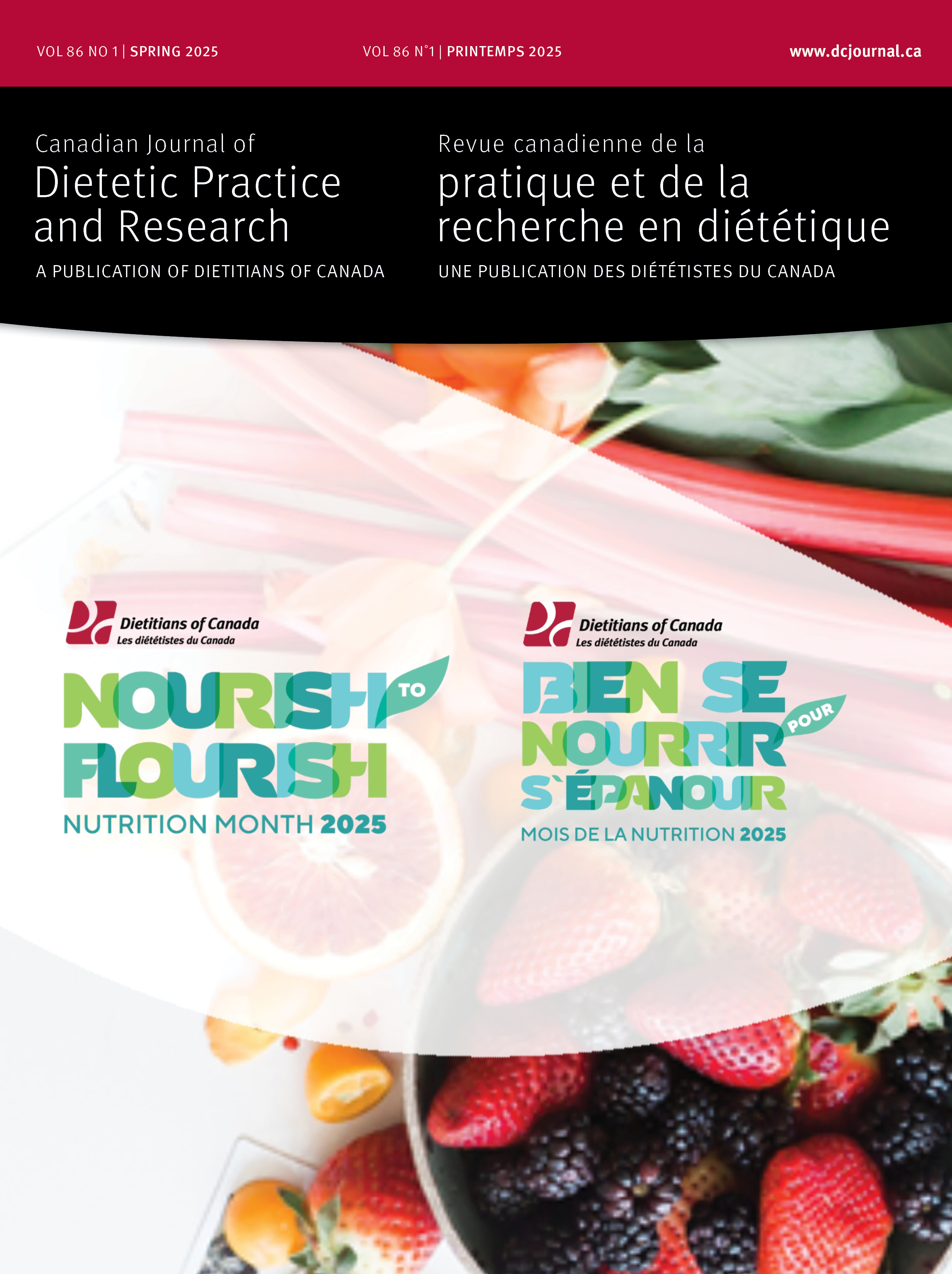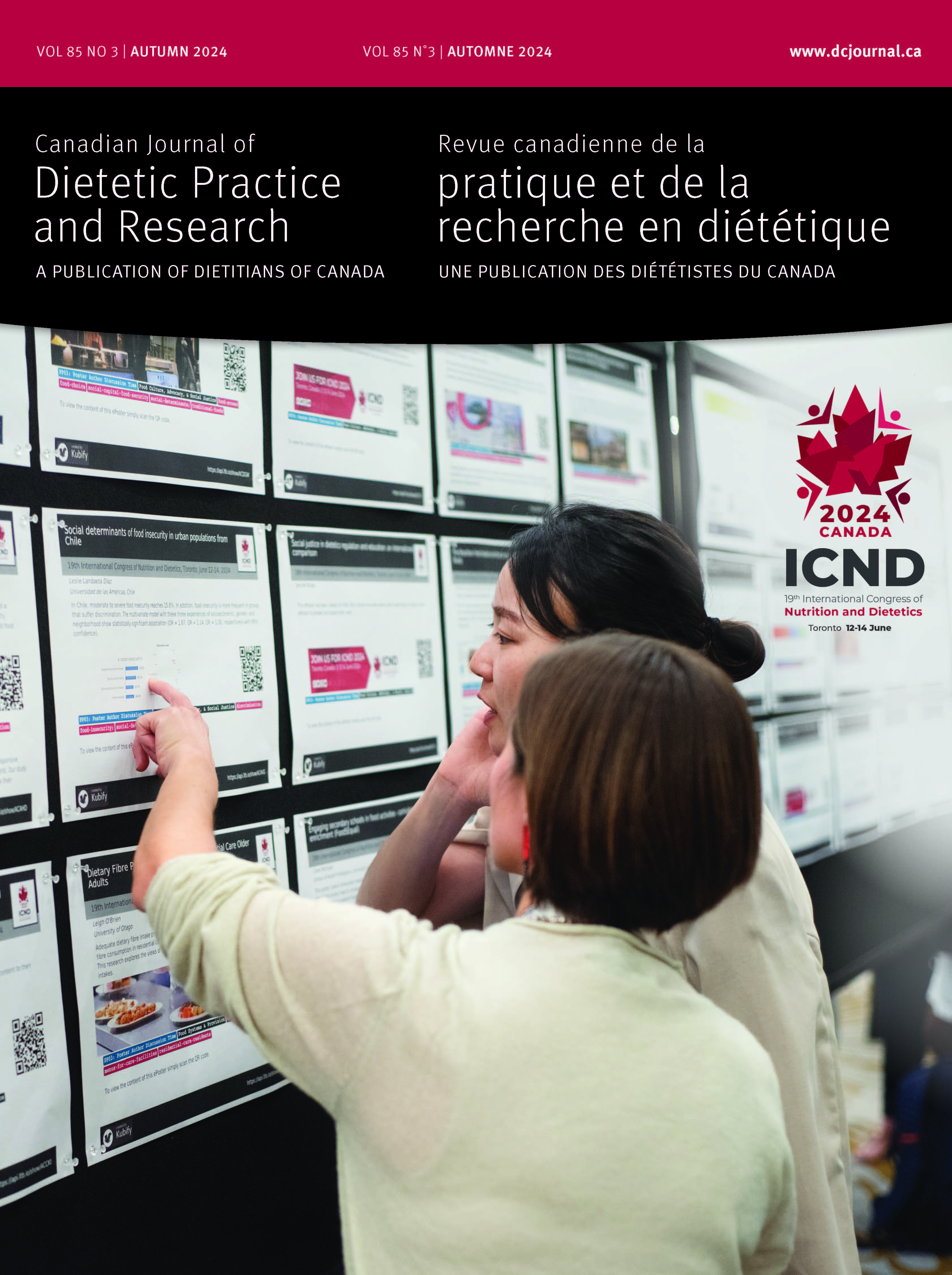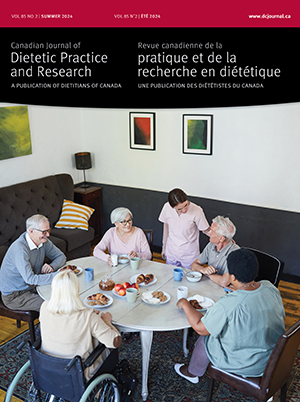Volume 70 • Number 4 • December 2009
Chair’s Message
Editor’s Message
Research
Purpose: The study was conducted to identify the enabling and barrier factors in the development of nutrition policies in Prince Edward Island elementary and consolidated schools. Methods: A document review and in-depth interviews were conducted with key stakeholders (n=12). Results: Principals were identified as important champions for change. Working group members created an interface between the school world and the nutrition world, and drew upon common philosophical ground to work together to lead the change process. Successfully navigating the process of policy development required building a case for change, testing policies in the real world, integrating healthy eating within school life, offering support to schools, engaging participants, and acknowledging the need to weigh the costs and benefits of the change. At times, external pressures on schools and available foods varied in the extent to which they enabled or challenged policy development. Finally, resource limitations, competing issues, and the use of unhealthy food as rewards were identified as the primary barriers. Conclusions: The use of a consultative approach that engages key stakeholders early in the process is critical to the successful development of school nutrition policies. This approach also may be an important predictor of the longterm success of such initiatives.
Purpose: The web-based Food Behaviour Questionnaire (FBQ) includes a 24-hour diet recall, a food frequency questionnaire, and questions addressing knowledge, attitudes, intentions, and food-related behaviours. The survey has been revised since it was developed and initially validated. The current study was designed to obtain qualitative feedback and to validate the FBQ diet recall. Methods: “Think aloud” techniques were used in cognitive interviews with dietitian experts (n=11) and grade six students (n=21).Multi-ethnic students (n=201) in grades six to eight at urban southern Ontario schools completed the FBQ and, subsequently, one-on-one diet recall interviews with trained dietitians. Food group and nutrient intakes were compared. Results: Users provided positive feedback on the FBQ. Suggestions included adding more foods, more photos for portion estimation, and online student feedback. Energy and nutrient intakes were positively correlated between FBQ and dietitian interviews, overall and by gender and grade (all p<0.001). Intraclass correlation coefficients were ≥0.5 for energy and macronutrients, although the web-based survey underestimated energy (-10.5%) and carbohydrate (-15.6%) intakes (p<0.05). Under-estimation of rice and pasta portions on the web accounted for 50% of this discrepancy. Conclusions: The FBQ is valid, relative to 24-hour recall interviews, for dietary assessment in diverse populations of Ontario children in grades six to eight.
Purpose: Nutrition students’ expectations for and experiences of their education were explored, as was the influence of the educational process on the students. Methods: In this qualitative research guided by a phenomenological approach, eight students in the first year and six in the final year of an undergraduate program completed semistructured interviews. Results: Although the students were diverse in terms of age, ethnicity, and class background, all stated that they wanted to become dietitians. Our findings illuminate the ways in which dietetic education influences students’ relationship with food, their bodies, bodies of knowledge, and family and friends. Professionalization, as initiated through discourse, necessitates a particular loss of relationship with the self. Although students enter with an awareness of professional norms and discourses, their education fosters an identity shift based on the kinds of nutrition knowledge and discourses they are learning, as these are performed by educators. Conclusions: Acknowledging that an embodied curriculum has an impact on professionalization is important for educators and students because education is a critical site for developing a professional identity; this identity then influences how dietitians practise. This research has implications for recruitment language, professional practice curricula, faculty development, the scholarship of teaching and learning, and ongoing support for students as they enter practice contexts.
Purpose: University science students who have taken a nutrition course possess greater knowledge of fats than do those who have not; whether students apply this knowledge to their diet is unknown. We measured and compared science students' total and saturated fat intake in the first and fourth years, and evaluated whether taking a nutrition course influenced fat consumption. Methods: A sample of 269 first- and fourth-year science students at a small undergraduate university completed a survey with both demographic questions and a semi-quantitative food frequency questionnaire about fats in the diet. Data were analyzed using chi-square tests and independent-sample t-tests. Results: Fourth-year science students consumed fewer grams of total and saturated fat than did first-year science students (p<0.001). Science students who had taken a nutrition course consumed fewer grams of total and saturated fat than did those who had not (p<0.001). Conclusions: Taking a nutrition course may decrease first-year students’ fat consumption, which may improve diet quality and decrease the risk of chronic disease related to fat consumption.
Purpose: Practices related to oral nutrition supplement (ONS) use were examined in elderly people living in longterm care (LTC) facilities. Methods: Thirteen LTC facilities within a large regional health authority participated, and 17 people responsible for prescribing ONS in their facilities were interviewed, using a key informant telephone survey. A survey on ONS practice wasmodified, pilot tested, and used. Results:Oral nutrition supplements were primarily prescribed by nursing staff (59%), followed by physicians, registered dietitians, or other staff; ONS use was prescribed for decreased intake, unintentional weight loss, or wound healing. Various ONS products (e.g., Ensure, Boost, or Resource 2.0) were prescribed. Only 18% of respondents reported using alternative food options first to supplement nutritional intake, before introducing ONS. In terms of follow-up and evaluation, the measures of improvement included weight gain, wound healing, or improved well-being; reasons for discontinuation included weight gain, increased intake, or death. Conclusions: Within LTC settings, the prescription and monitoring of ONS vary considerably. Evidence-based guidelines for the prescription and monitoring of ONS and for the use of a food-first strategy should be developed, implemented, and evaluated to optimize the nutritional health of the elderly in LTC facilities.
Purpose: The interest in, intent to, and impact of consuming foods fortified with vitamins and minerals, particularly foods of poor nutritional quality, were evaluated among Canadians. Methods: A Canada-wide, online survey of 1200 adults and teens was used to assess the interest in, intent to, and impact of consuming or serving foods fortified under two fortification scenarios (10% and 20% of the Recommended Daily Value). Categories of foods tested were cereal bars, energy bars, flavoured bottled water, frozen desserts, fruit drinks, fruit juice, salty snacks, soda pop, sports drinks, sweet baked goods, and sweets. Results: The majority of adults and teens were interested in consuming fortified foods and indicated that they would increase their current consumption of specific foods if they became fortified. These foods included soft drinks, salty snacks, fruit drinks, and fruit juice. A large proportion of adults also indicated that they would serve more of these fortified foods to their children. Conclusions: Our findings reveal that fortifying foods, particularly those of poor nutritional quality, could lead to increased consumption of these foods among children, teens, and adults. Potentially, this could have a negative impact on eating habits and, in turn, could exacerbate the current nutrition-related health issues that Canadians face.
Perspectives in Practice
Patient food service is an important component in the nutritional management of hospitalized children. The previous meal delivery system at The Hospital for Sick Children in Toronto was a cold-plating re-thermalized system. Issues related to this model included order lead time, the reheating process, menu selection, and service style. Research into other systems led us toward room service, an innovative and flexible mode of meal delivery. Transformation to room service occurred over one year, and included implementation of a new computer system, kitchen renovation, redesign of menus and a new meal delivery system called Meal Train, and changes to human resource allocations. Throughout the transformation, consultations were held with key stakeholders, including the children’s council, the family advisory, the nursing council, and a multidisciplinary committee involving nursing staff, dietitians, patient service aides, infection control personnel, occupational health employees, patient representatives, and food services staff. Now, Meal Train is running smoothly, and meal days and food costs have been reduced. Others considering a project like this must know their clients’ needs and be willing to think outside the box. They should familiarize themselves with current information on systems and equipment, consult with key stakeholders within their organization, and then create the system that will work for them.
Zinc deficiency has been reported in individuals with eating disorders, the risks of which increase during the adolescent and early adult years. A food frequency questionnaire (FFQ) specific for zinc-rich foods was tested for its usefulness in identifying problematic eating behaviour tendencies in college-age women. Ninety-two female students enrolled in a university introductory psychology course volunteered to complete demographic information, the Eating Attitudes Test (EAT-26), and a zinc-specific FFQ (ZnFFQ). Relationships among estimated zinc intakes, food/lifestyle habits, and eating attitude variables were examined. Twenty-five women had estimated intakes below the Recommended Dietary Allowance (RDA) for zinc. Individuals in the highest zinc intake group (over twice the RDA) had a tendency to score higher on the EAT-26 and the bulimia subscale. Vegetarians also scored high on the EAT-26. Although our data are limited, the ZnFFQ should be studied further to determine whether it could play a useful role in identifying individuals at risk for bulimia. The ZnFFQ is a simple, non-confrontational assessment tool and may be a helpful starting point for identifying women with unhealthy eating habits.










